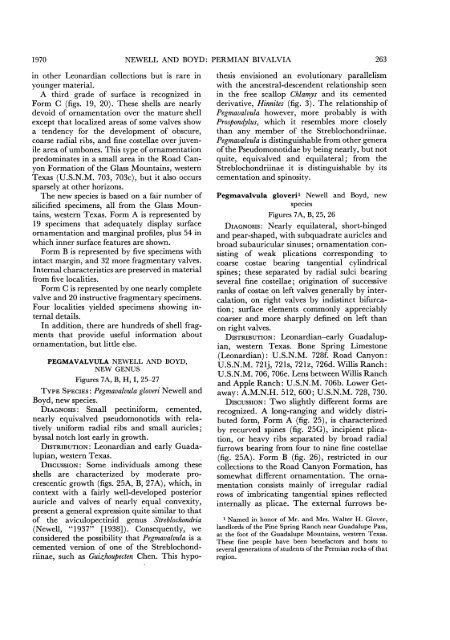IDY TE1>t' I- - American Museum of Natural History
IDY TE1>t' I- - American Museum of Natural History
IDY TE1>t' I- - American Museum of Natural History
You also want an ePaper? Increase the reach of your titles
YUMPU automatically turns print PDFs into web optimized ePapers that Google loves.
1970 NEWELL AND BOYD: PERMIAN BIVALVIA<br />
263<br />
in other Leonardian collections but is rare in<br />
younger material.<br />
A third grade <strong>of</strong> surface is recognized in<br />
Form C (figs. 19, 20). These shells are nearly<br />
devoid <strong>of</strong> ornamentation over the mature shell<br />
except that localized areas <strong>of</strong> some valves show<br />
a tendency for the development <strong>of</strong> obscure,<br />
coarse radial ribs, and fine costellae over juvenile<br />
area <strong>of</strong> umbones. This type <strong>of</strong> ornamentation<br />
predominates in a small area in the Road Canyon<br />
Formation <strong>of</strong> the Glass Mountains, western<br />
Texas (U.S.N.M. 703, 703c), but it also occurs<br />
sparsely at other horizons.<br />
The new species is based on a fair number <strong>of</strong><br />
silicified specimens, all from the Glass Mountains,<br />
western Texas. Form A is represented by<br />
19 specimens that adequately display surface<br />
ornamentation and marginal pr<strong>of</strong>iles, plus 54 in<br />
which inner surface features are shown.<br />
Form B is represented by five specimens with<br />
intact margin, and 32 more fragmentary valves.<br />
Internal characteristics are preserved in material<br />
from five localities.<br />
Form C is represented by one nearly complete<br />
valve and 20 instructive fragmentary specimens.<br />
Four localities yielded specimens showing internal<br />
details.<br />
In addition, there are hundreds <strong>of</strong> shell fragments<br />
that provide useful information about<br />
ornamentation, but little else.<br />
PEGMAVALVULA NEWELL AND BOYD,<br />
NEW GENUS<br />
Figures 7A, B, H, I, 25-27<br />
TYPE SPECIES: Pegmavalvula gloveri Newell and<br />
Boyd, new species.<br />
DIAGNOSIS: Small pectiniform, cemented,<br />
nearly equivalved pseudomonotids with relatively<br />
uniform radial ribs and small auricles;<br />
byssal notch lost early in growth.<br />
DISTRIBUTION: Leonardian and early Guadalupian,<br />
western Texas.<br />
DISCUSSION: Some individuals among these<br />
shells are characterized by moderate procrescentic<br />
growth (figs. 25A, B, 27A), which, in<br />
context with a fairly well-developed posterior<br />
auricle and valves <strong>of</strong> nearly equal convexity,<br />
present a general expression quite similar to that<br />
<strong>of</strong> the aviculopectinid genus Streblochondria<br />
(Newell, "1937" [1938]). Consequently, we<br />
considered the possibility that Pegmavalvula is a<br />
cemented version <strong>of</strong> one <strong>of</strong> the Streblochondriinae,<br />
such as Guizhoupecten Chen. This hypo-<br />
thesis envisioned an evolutionary parallelism<br />
with the ancestral-descendent relationship seen<br />
in the free scallop Chlamys and its cemented<br />
derivative, Hinnites (fig. 3). The relationship <strong>of</strong><br />
Pegmavalvula however, more probably is with<br />
Prospondylus, which it resembles more closely<br />
than any member <strong>of</strong> the Streblochondriinae.<br />
Pegmavalvula is distinguishable from other genera<br />
<strong>of</strong> the Pseudomonotidae by being nearly, but not<br />
quite, equivalved and equilateral; from the<br />
Streblochondriinae it is distinguishable by its<br />
cementation and spinosity.<br />
Pegmavalvula gloveril Newell and Boyd, new<br />
species<br />
Figures 7A, B, 25, 26<br />
DIAGNOSIS: Nearly equilateral, short-hinged<br />
and pear-shaped, with subquadrate auricles and<br />
broad subauricular sinuses; ornamentation consisting<br />
<strong>of</strong> weak plications corresponding to<br />
coarse costae bearing tangential cylindrical<br />
spines; these separated by radial sulci bearing<br />
several fine costellae; origination <strong>of</strong> successive<br />
ranks <strong>of</strong> costae on left valves generally by intercalation,<br />
on right valves by indistinct bifurcation;<br />
surface elements commonly appreciably<br />
coarser and more sharply defined on left than<br />
on right valves.<br />
DISTRIBUTION: Leonardian-early Guadalupian,<br />
western Texas. Bone Spring Limestone<br />
(Leonardian): U.S.N.M. 728f. Road Canyon:<br />
U.S.N.M. 721j, 721s, 721z, 726d. Willis Ranch:<br />
U.S.N.M. 706, 706e. Lens between Willis Ranch<br />
and Apple Ranch: U.S.N.M. 706b. Lower Getaway:<br />
A.M.N.H. 512, 600; U.S.N.M. 728, 730.<br />
DISCUSSION: Two slightly different forms are<br />
recognized. A long-ranging and widely distributed<br />
form, Form A (fig. 25), is characterized<br />
by recurved spines (fig. 25G), incipient plication,<br />
or heavy ribs separated by broad radial<br />
furrows bearing from four to nine fine costellae<br />
(fig. 25A). Form B (fig. 26), restricted in our<br />
collections to the Road Canyon Formation, has<br />
somewhat different ornamentation. The ornamentation<br />
consists mainly <strong>of</strong> irregular radial<br />
rows <strong>of</strong> imbricating tangential spines reflected<br />
internally as plicae. The external furrows be-<br />
1 Named in honor <strong>of</strong> Mr. and Mrs. Walter H. Glover,<br />
landlords <strong>of</strong> the Pine Spring Ranch near Guadalupe Pass,<br />
at the foot <strong>of</strong> the Guadalupe Mounitains, western Texas.<br />
These fine people have been benefactors and hosts to<br />
several generations <strong>of</strong> students <strong>of</strong> the Permian rocks <strong>of</strong> that<br />
region.
















